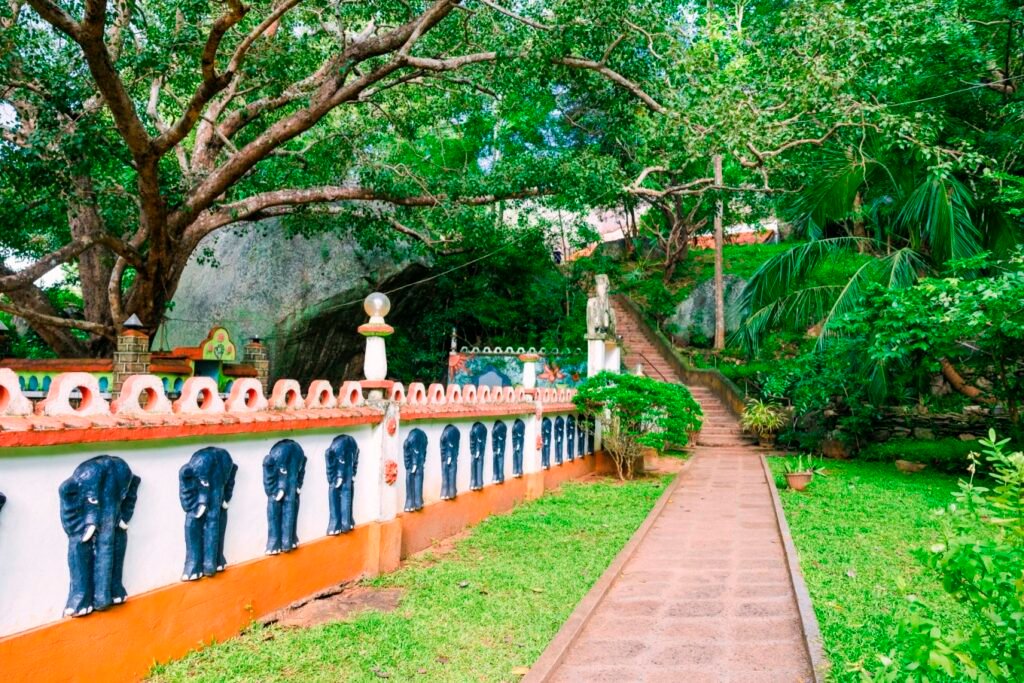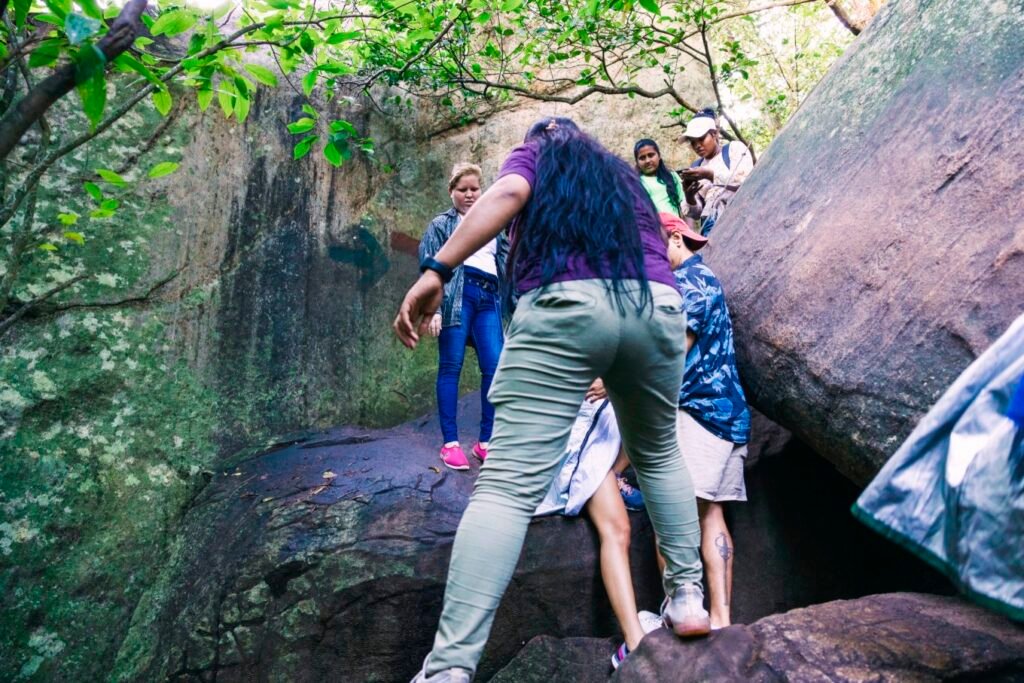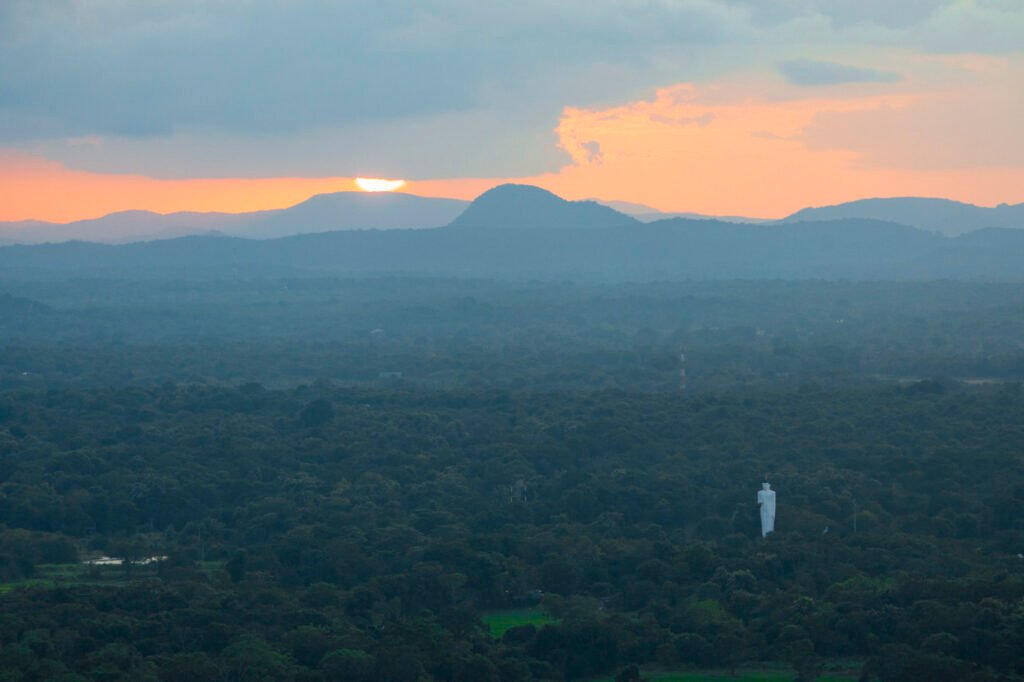We plan to stay two nights in Sigiriya, as we aim to visit Lion Rock before sunset. To pass the time during the day, we asked our driver, Kingsley, to recommend a spa. Treating ourselves to a spa session before tackling the climb seemed like a good idea. Among all the ancient sites in Sri Lanka, Lion Rock, located in the ancient city of Sigiriya, is undoubtedly the most famous. The Sri Lankan national flag still bears the image of a “sword-wielding lion,” a symbol of the sacred significance Lion Rock holds in the hearts of the Sri Lankan people.
Since we plan to film aerial shots, we decided not to climb Lion Rock directly. Instead, we chose to hike up Pidurangala Rock, a smaller hill located across from Lion Rock. Known for its stunning natural scenery and relatively affordable entrance fee, Pidurangala Rock has become a hidden gem in Sri Lanka’s tourism scene. This hill offers not only beautiful views but also a more authentic, less-commercialized experience, allowing visitors to feel fully immersed in nature.


Additionally, compared to Lion Rock, Pidurangala Rock offers a more budget-friendly option, with tickets priced at just 500 LKR. In contrast, the entrance fee for Lion Rock is significantly higher and considered quite expensive for tourists, though locals can enter for free. As a result, Pidurangala Rock has become a great value destination, especially for travelers seeking to avoid crowds and immerse themselves in the beauty of nature.


The entrance to the hike is right next to Pidurangala Temple, marked by a staircase that’s easy to find. The climb to the top of Pidurangala takes about 45 minutes. Inside the temple, you’ll come across several ancient stone caves and Buddha statues. From the temple, you follow the steps until you reach a reclining Buddha statue, after which the stairs end. From there, you’ll need to walk along a short trail for several meters and climb over some large boulders to finally reach the summit platform.


The climb up Pidurangala Rock is somewhat challenging, requiring both hands and feet to navigate over large boulders. However, the effort is well worth it, as the summit offers breathtaking panoramic views. With fewer crowds and stunning scenery, many travelers prefer Pidurangala over the busy Lion Rock as a photography spot.


The ancient city of Sigiriya is essentially a fortified palace built atop the 200-meter-high Lion Rock. It was constructed in the 5th century AD by a king who had fled to this area and created a palace in the sky. The fortress’s magnificent architecture and the dramatic cliffs are truly awe-inspiring. The rock, a natural monolith standing 180 meters tall, resembles a lion raising its head, hence the name Lion Rock. It is both a national treasure and a cultural gem of Sri Lanka.
In the 5th century AD, Prince Kashyapa seized the throne by killing his father. Fearing that his exiled brother would return for revenge, he relocated the capital to Lion Rock and built a palace known as the Sky Palace. To reach this palace, one had to ascend stairways and corridors carved into the sheer cliffs.
The ancient palace of Sigiriya is situated on a monolithic rock southeast of Anuradhapura, the ancient western capital. According to historical records, the palace was once grand and opulent, with exceptional design, construction, and landscaping. Today, only the stone foundations, pillars, the remains of the king’s throne, and the palace gardens survive.
Sigiriya’s most distinctive feature is its rock frescoes and mirror wall inscriptions. The fresco gallery, located halfway up the rock, once contained over 500 vivid and captivating paintings, though only about 20 remain today. Not far from the frescoes is a smooth stone wall known as the Mirror Wall, etched with poems in Sinhalese, Tamil, and Sanskrit. These inscriptions, carved with precise strength and artistry, are collectively known as the “Mirror Wall Poems.”
In Sri Lankan literature and art, the frescoes and inscriptions of Sigiriya are regarded as one of the four great cultural treasures of Southeast Asia, on par with Angkor Wat in Cambodia.


Lion Rock rises majestically within the coconut forests of Sigiriya, where the trees are taller and more robust than those on the plains. Lion Rock sits at the heart of this lush landscape. In fact, the name Lion Rock refers not only to the massive rock formation emerging from the plains but also to the gardens and palaces built atop it. Unfortunately, after centuries of weathering, the once-magnificent palace has been reduced to ruins, with only a few remnants left behind.
The orange-red base of Lion Rock resembles the Ayers Rock (Uluru) in Australia, the world’s largest monolith. However, Lion Rock offers far more than just natural grandeur—it boasts astonishing man-made wonders. The masterfully designed palaces and gardens, the exquisite rock frescoes, the gleaming Mirror Wall, and reservoirs that transform into fountains during the rainy season all set Lion Rock apart. Forgotten in the jungle for over a thousand years, it was rediscovered in the mid-19th century by British explorer H.C.P. Bell and has since captured global attention.
Lion Rock served not only as a military fortress but also as a king’s palace and a religious site. Even after millennia of exposure to the Indian Ocean’s sea breeze, it retains its enigmatic and legendary allure. Now standing boldly atop the rock at an elevation of 377 meters and rising over 200 meters vertically from the ground, Lion Rock, though not exceptionally tall, appears strikingly prominent in the flat plains. Its orange-red hues make it even more dazzling, and despite centuries of wind and rain, it still towers proudly over the surrounding jungle.
Midway up the rock, the original builders created a giant stone lion from brick and stone, intended to ward off evil spirits. Sadly, the lion’s head has long since eroded, leaving only its two massive paws behind. Even so, the two-meter-tall paws, with their sharp claws, offer a glimpse of the imposing and majestic lion that once guarded the entrance, standing proudly over the centuries.
At the summit of Lion Rock lies the ruins of a sky palace, still retaining the outlines of its former grandeur. Remnants of a monastery, intricate caves, urban gardens, and the royal swimming pool are still visible, with the pool being the best-preserved structure.


Although the palace has been reduced to rubble, the red bricks and marble structures scattered across the summit still reveal hints of the buildings that once stood here. From the remaining stone pillars and foundations, you can faintly discern the layout of the former structures, with levels rising and falling across the mountaintop. The intricate patterns adorning the broken walls, like woven tapestries, offer a glimpse into the splendor and prosperity of the past.
The grandeur of the royal chambers, the lively banquet halls, the brightly lit council rooms, the regal king’s throne, and the well-preserved swimming pool all reflect the majesty of the ancient kingdom that once thrived atop this giant rock. From Pidurangala Rock, you can look out at Lion Rock, surrounded by endless jungle greenery, offering an unbroken view of the entire ancient city. One can only imagine what thoughts must have crossed Kashyapa’s mind 1,500 years ago as he gazed upon the kingdom he had schemed so hard to seize.
Today, Lion Rock is merely a massive monolith towering over the ruins beneath it. Yet, if you take the time to sit quietly on the summit, close your eyes, and let your mind wander on the evening breeze, you might catch a fleeting glimpse of what this magical and awe-inspiring city once was. It’s hard not to feel a sense of regret for all that has been lost to the ravages of time and war.




